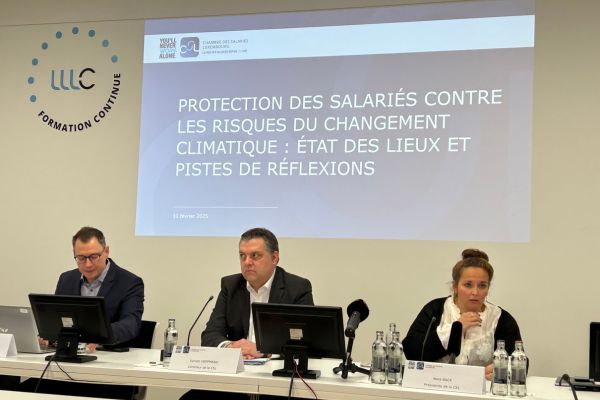 (L-R): David Büchel, CSL Executive Advisor; Sylvain Hoffmann, CSL Director; Nora Back, CSL President;
Credit: Helen O'Mahony, Chronicle.lu
(L-R): David Büchel, CSL Executive Advisor; Sylvain Hoffmann, CSL Director; Nora Back, CSL President;
Credit: Helen O'Mahony, Chronicle.lu
On Tuesday 11 February 2025, Luxembourg’s Chamber of Employees (Chambre des Salariés - CSL) presented the results of an analysis carried out on the impact of climate change on the health and safety of employees, at a press conference held in Luxembourg-Bonnevoie.
CSL’s President, Nora Back, Vice-President, Jean-Claude Reding, Director, Sylvain Hoffmann, and Executive Advisors, David Büchel and Martine Mirkes, presented the results, accompanied by a list of demands, aimed at protecting employees against the risk of climate change.
The report noted that 2024 was the hottest year ever recorded on earth. As a result, Luxembourg’s International Labour Organisation (Organisation Internationale du Travail - OIT) has identified a series of risks to workers due to adverse climate conditions, including heatwaves, ultraviolet radiation (UV), extreme cold, extreme weather events, air pollution at work, exposure to agrochemicals and vector-borne diseases. These weather events are reported to affect public health, productivity and infrastructure, among others.
According to the CSL, climate change exposes up to 70% of the world’s workers to serious risks. The sectors most affected include agriculture and construction workers, those who work outdoors, as well as physically and mentally vulnerable people. Employers have a duty, under the Labour Code, to guarantee the health and safety of their employees by identifying and evaluating risk factors, empowering employees and putting preventative measures in place. A list of accidents at work should be maintained and reported to the Inspectorate of Labour and Mines (ITM).
Preventative measures cited in the report, for those working outside during periods of increased heat /UV, include the provision of sheltered areas, 3-4 litres of water daily per person, a reduction of physical labour, clothes with a high UV protection and suncream. For inside workers, temperature monitoring, adequate ventilation, air conditioning and provision of water are all mentioned. During periods of extreme cold, employees are obliged to maintain minimal temperatures (as outlined by the ITM. During extreme weather events, employers have a legal duty to secure the safety of workers. This includes respecting government warnings. Employers also have legal obligations regarding protecting employees from air pollution and vector-borne diseases.
The CSL also spoke of other legally obliged requirements that should be implemented to protect workers against the aforementioned adverse climate conditions. These include health and safety requirements as outlined by the ITM. It also stated that the law of 17 June 1994, concerning the health and safety of workers, does not give clear guidelines nor guarantee the safety of employees in this area. It recommended the creation of European directives to ensure parity of protection in all EU member states and called on the Luxembourg government to implement a national preventive action plan.
Other measures proposed by the CSL involve the inclusion and updating of climate change risks in occupational health and safety protocols. Continued risk monitoring and data collection is expected to allow a better understanding of the impacts of climate change on workers. The CSL also recommended ongoing training and awareness programmes as well as protective measures against the risk factors of climate change.
HOM








